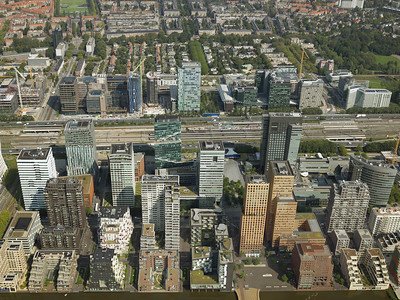Introducing: the Zuidas accessibility task force
The Zuidas Accessibility Task Force was established in 2016 with the purpose of fostering a dialogue between government and the business community in Zuidas about area access. As well as advising government on measures, the Task Force monitors accessibility and evaluates zoning plans. All the measures associated with the Covid-19 situation will radically change mobility in and around Zuidas. Anne Bijlmer (Zuidas Accessibility and Main Infrastructure Manager for the Municipality of Amsterdam), René Teeuwen (Chair of the Zuidas Accessibility Task Force), Stefan Titus (Secretary of the VU Amsterdam Campus Development Programme) and Jos Hollestelle (Account Manager at Van A tot Zuidas) discuss what this means.
What’s the aim of the Task Force?
René Teeuwen, Chair of the Zuidas Accessibility Task Force: ‘The Zuidas Accessibility Task Force works to foster dialogue between the business community and the Zuidas Amsterdam Development Office and Zuidasdok organization about access to the district. We have three tasks. The first is to advise on mobility and on plans and measures to keep Zuidas accessible. To inform that process, the Task Force commissions mobility and traffic studies – that’s our second task, and the results are made public on an accessibility dashboard, you can see how many people are travelling to and from Zuidas at different times, which modalities are being used and traveller ratings. The Zuidas Amsterdam Development Office, Zuidasdok and businesses can use this information to shape their mobility policies and measures. You can find the dashboard on the vanAtotZuidas.nl website. Our third task may be the most important one and also the most challenging to implement: getting employers to actively reduce the car ratio in all transport movements, and also to reduce rush-hour travel. The Task Force advises and assists its members with this, and they in turn share their knowledge.’

If more people choose not to travel by public transport in favour of commuting by car or bike, it will be up to businesses and the municipality to jointly ensure Zuidas is still accessible. How will that cooperation work?
Anne Bijlmer, Zuidas Accessibility and Main Infrastructure Manager for the Municipality of Amsterdam: ‘These last few years we’ve been working closely with companies via the Task Force to maintain and improve the level of area access. It’s become clear to everyone on the Task Force that we all need each other to achieve this. So one of the ways we as a municipality do this, is by informing Task Force members of development plans for Zuidas and the associated traffic impacts. Our collaboration has also led to things like starting up Mobility as a Service for Zuidas. Going forward, I expect the Task Force will also help us pinpoint the right measures to keep Zuidas attractive and accessible during these tough times. For the municipality, it’s important to know how companies plan to restart in the period ahead and what their mobility needs are. The other side of it is that we have to adapt public spaces in line with the directives for a six-foot society. We also must ensure Zuidas residents and businesses are well informed.’

A large share of VU students take public transport into Zuidas. How will the university handle that in the new six-foot society?
Stefan Titus, Secretary of the VU Amsterdam Campus Development Programme: ‘The new academic year starts in September. We’d love nothing better than to give all our students a warm welcome on campus as we do every year. But, sadly, this year will be different. Our motto now will be: on campus if possible, online because it’s possible. Fortunately, we can still give face to face classes on campus, but only to a limited extent. That will help us keep the relative share of VU students on public transport evenly distributed. Our students will travel outside rush hours, between 10 and 11 in the mornings and 3 and 4 in the afternoons, and after 8 in the evenings. We’ve reached out to companies in Zuidas whose employees use Amsterdam Zuid Station, urging them to arrive or leave before our peak hours – so to arrive in Zuidas before 10:30 am and leave before 7:30 pm – so as to prevent the risk of contact and infection.’

